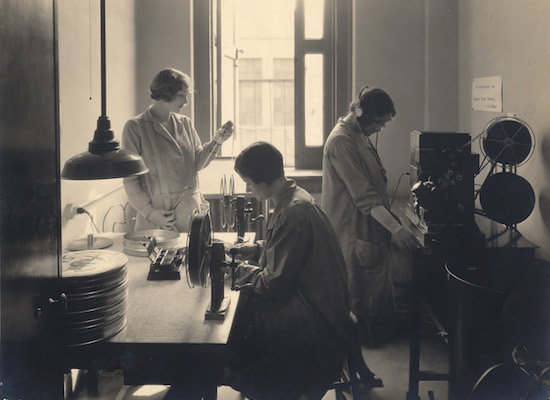
Edna Rollins, Mildred Califano, and Helene Turner in an editing room at the Astoria Studio in the early 1930s. The building that now houses Museum of the Moving Image is visible through the window.
COLLECTION SPOTLIGHT: THE ASTORIA STUDIO
March 31, 2020—
Museum of the Moving Image presents a new online series that traces the fascinating history of the Astoria Studio, which has been at the heart of filmmaking in New York City since 1920. Now celebrating its 100th anniversary, the Astoria Studio is a New York City landmark, and is the first motion picture studio in the country to be listed on the National Register of Historic Places, cited for its architectural significance and its extensive role in the history of American cinema.
Known affectionately as “The Big House” by three generations of filmmakers because of its monumental main stage, the Astoria Studio was opened by Famous Players-Lasky (later Paramount) in 1920 as its East Coast production center. Such stars as Rudolph Valentino, Gloria Swanson, and W.C. Fields brought glamour to its stages in the silent film era. The Marx Brothers and Claudette Colbert made their first talking pictures there after the Studio’s transition to sound. Over the decades, the Studio complex expanded steadily into the residential streets adjacent to its main building, eventually covering more than five acres. With Paramount’s departure in 1932, the Studio became a rental facility until the U.S. Army purchased it in 1942, turning the site into a center for military motion picture production and distribution for the next 30 years. After falling into disrepair in the early 1970s, a unique public/private partnership transformed the ailing studio complex, leading to the establishment of Kaufman Astoria Studios and to the founding of Museum of the Moving Image. Since its revival, the Studio has thrived, providing stages for such films as The Age of Innocence, Scent of a Woman, The Bourne Ultimatum, and The Irishman, and a home for the production of such television shows as Orange Is the New Black, The Affair, and Sesame Street.
Using film stills, behind-the-scenes photographs, oral histories, posters, and other artifacts from MoMI’s permanent collection, the series explores five eras of the Studio’s history, with content shining a light on the filmmakers, actors, and craftspeople who worked in front of the camera and behind the scenes at the Astoria Studio. Follow the series to see how this storied complex in Queens has remained a vital site of filmmaking from the arrival of the “talkies” through the digital streaming revolution.
Organized by Barbara Miller, Director of Curatorial Affairs
Paramount (1920–1932)
Eastern Service Studios (1933–1941)
Army Pictorial Center (1942–1970)
Revival (1976–1979)
Renaissance (1980–present)
Past Collection Spotlights
View »
Tut's Fever Movie Palace (December, 2013)
Special Effects Makeup (September, 2013)
Optical Toys (July, 2013)
Licensed Merchandise (May, 2013)
Television Receivers (March, 2013)
Video Games (February, 2013)
The Panaflex Camera (January, 2013)
Glass Slides (October, 2012)
The Bunin Puppets (July, 2012)
Paramount at the Astoria Studios (March, 2012)
Production Design (January, 2012)
Race Movies (October, 2011)
Richard Hoffman's Collection (July, 2011)

